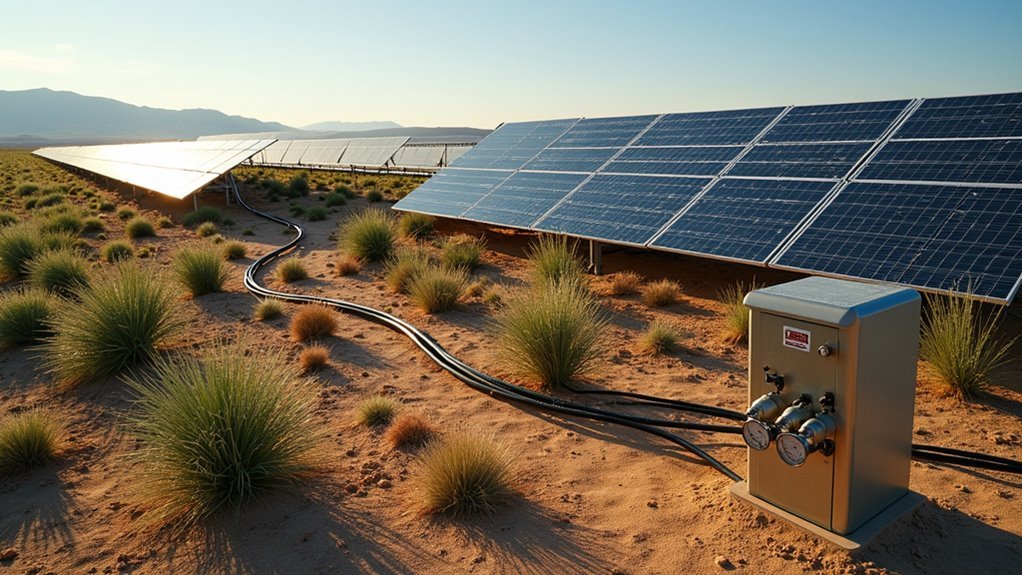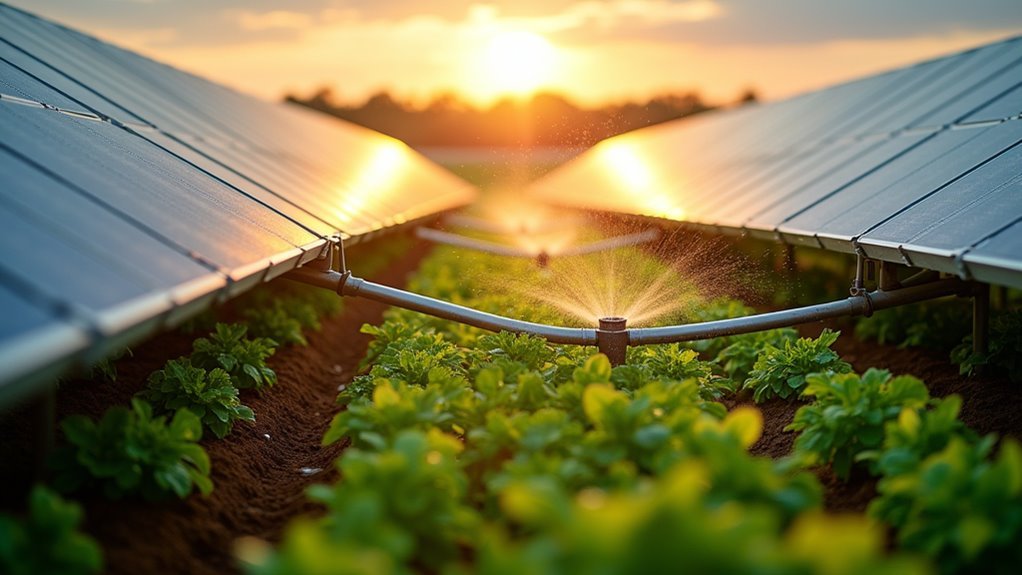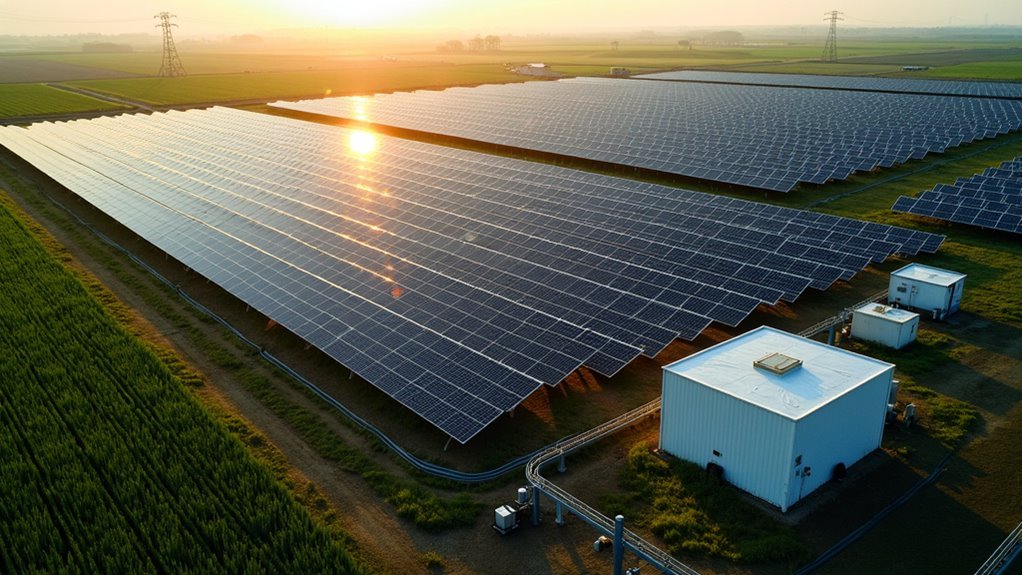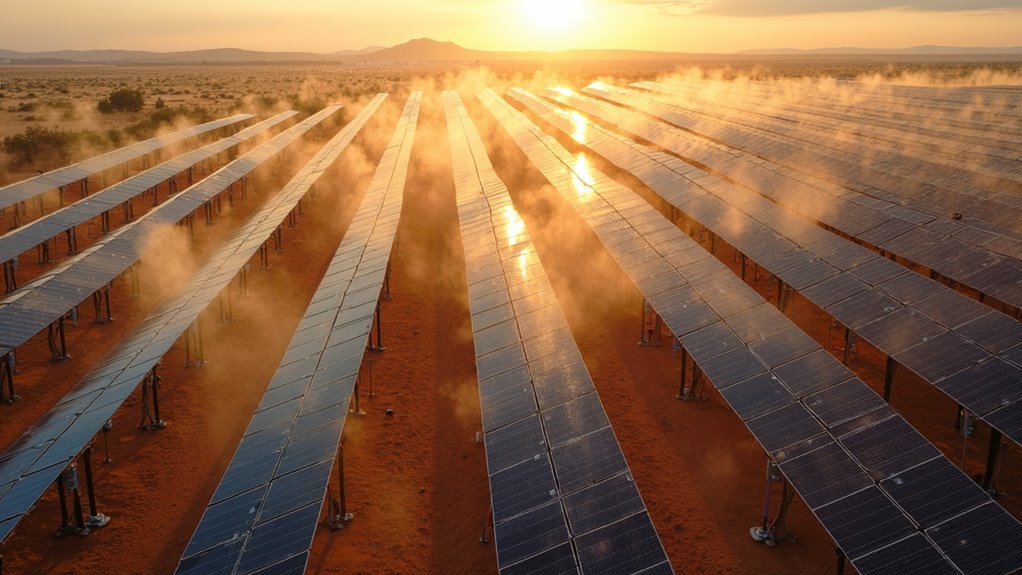You’ve likely seen traditional irrigation systems that depend on grid electricity or diesel generators, but solar plant irrigation systems offer a game-changing alternative. These innovative setups harness the sun’s energy to power water pumps that deliver precise amounts of water directly to your crops. What makes them particularly compelling isn’t just their environmental benefits—it’s how they can transform your farming operations in ways you might not expect.
Understanding Solar Plant Irrigation Technology

Solar plant irrigation systems revolutionize farming by converting sunlight into a reliable water delivery mechanism for your crops.
These innovative solar-powered irrigation systems harness solar energy to power pumps that deliver water directly to your plants, dramatically reducing dependence on traditional electricity sources.
Your system typically includes solar panels, pumps, irrigation lines, and control mechanisms that adjust water output based on real-time sunlight intensity and crop requirements.
Smart solar irrigation systems automatically adjust water flow by monitoring sunlight levels and specific crop needs in real-time.
You’ll benefit from efficient water delivery without expensive battery backups, as these systems operate during daylight hours when solar energy’s most abundant.
These technologies promote sustainable agricultural practices, particularly in rural areas facing water scarcity and limited electrical access.
Core Components of Solar Plant Irrigation Systems
Innovation starts with understanding each component that makes your solar plant irrigation system function effectively.
Solar panels serve as your primary energy source, capturing sunlight and converting it into electricity that powers your entire setup.
You’ll need water pumps to move water from sources to your crops—choose submersible pumps for deep wells or surface pumps for shallow sources.
Charge controllers regulate energy flow to your energy storage batteries, preventing overcharging while maintaining peak performance.
Your irrigation systems rely on durable pipes and hoses made from PVC or polyethylene to transport water efficiently.
Finally, emitters like drippers and sprinklers guarantee precise water delivery directly to your plants, with selection depending on your specific crop requirements and chosen irrigation method.
How Solar Panels Power Plant Watering Systems

You’ll find that solar panels consist of photovoltaic cells, inverters, and mounting systems that work together to capture and convert sunlight.
These components transform solar energy into electrical power through the photovoltaic effect, where sunlight strikes the cells and generates direct current electricity.
The system then converts this DC power to AC electricity that can operate your irrigation pumps and control systems effectively.
Solar Panel Components
When sunlight hits photovoltaic cells, your solar panels begin the remarkable process of converting solar energy into electricity that’ll power your plant watering systems.
Your solar-powered irrigation systems rely on several key components working together seamlessly.
- Solar panels – Monocrystalline panels deliver the highest efficiency at 17-22%, while polycrystalline and thin-film options provide cost-effective alternatives with lower efficiency rates.
- Charge controllers – These regulate electrical flow from panels to batteries and irrigation pumps, preventing overcharging damage while ensuring peak performance.
- Inverters – Pure sine wave inverters convert DC electricity from your panels into clean AC power for your pumps.
Proper integration of these components with energy storage batteries and filtration systems creates reliable irrigation solutions for your agricultural needs.
Energy Conversion Process
Understanding these components sets the foundation for grasping how your solar panels actually transform sunlight into water flow for your crops. The energy conversion process begins when solar panels capture sunlight through the photovoltaic effect, generating DC electricity. This electricity generated powers electric motor pumps that draw water from boreholes or reservoirs for your irrigation systems.
| Component | Function | Output Type |
|---|---|---|
| Solar Panels | Convert sunlight to electricity | DC Power |
| Charge Controller | Manages energy flow | Regulated DC |
| Inverter | Converts DC to AC | AC Power |
| Electric Pump | Moves water through system | Water Flow |
Charge controllers optimize performance and prevent overcharging, while inverters enable AC compatibility. Your solar power system’s efficiency depends on panel type, sunlight intensity, and irrigation design.
Types of Solar Water Pumps for Plant Irrigation
Since water sources vary dramatically across agricultural landscapes, solar water pumps come in two distinct categories designed to match your specific irrigation needs.
Agricultural water sources demand tailored solar pump solutions that precisely match your farm’s unique irrigation requirements and landscape challenges.
Submersible pumps operate underwater and excel at accessing deep aquifers beyond 300 feet. They’re engineered for consistent water flow rates that depend on your solar panel capacity and pump design. You’ll find these ideal when you’re pumping water from wells or underground sources.
Surface pumps draw from shallow sources like rivers and reservoirs. They’re easier to maintain and perfect for small to medium-sized farms requiring water distribution over shorter distances.
Consider these key factors when selecting your pump:
- Water source depth – determining submersible versus surface requirements
- Required flow rate – matching pump capacity to irrigation demands
- Crop cultivation needs – aligning system output with agricultural goals
Battery Storage and Power Management

You’ll need reliable battery storage to keep your solar irrigation system running when the sun isn’t shining.
Your choice of battery type—whether lead-acid, lithium-ion, or nickel-cadmium—directly impacts your system’s lifespan and efficiency.
Proper charge controllers and storage optimization guarantee you’re maximizing every bit of solar energy while protecting your investment from costly damage.
Battery Types and Selection
When selecting batteries for your solar irrigation system, you’ll need to weigh three primary options: lead-acid, lithium-ion, and nickel-cadmium batteries, each offering distinct advantages and trade-offs that directly impact your system’s performance and long-term costs.
Lead-acid batteries represent the most budget-friendly choice upfront, but they’ll require regular maintenance and typically last only 5-10 years.
Lithium-ion options cost more initially but deliver superior efficiency and can serve your solar irrigation systems for up to 15 years with minimal upkeep.
Nickel-cadmium batteries fall somewhere between these extremes.
Consider these key factors when choosing:
- Budget constraints – Balance upfront costs against long-term replacement needs
- Maintenance capacity – Evaluate your ability to perform regular battery care
- System demands – Match energy density requirements with pump specifications
Proper charge controllers will optimize whichever battery types you select.
Charge Controller Functions
Charge controllers serve as the critical link between your solar panels and battery storage, regulating electrical flow to protect your investment from the damaging effects of overcharging and deep discharge cycles.
You’ll encounter two main types: PWM controllers offer cost-effective voltage matching, while MPPT controllers enhance performance under varying conditions. These MPPT controllers can boost energy capture by up to 30% compared to PWM units, greatly improving your solar irrigation system’s efficiency.
Your charge controller maintains ideal battery charge levels, ensuring consistent power availability during cloudy periods and nighttime operations.
Regular maintenance, including connection inspections and functionality checks, maximizes battery lifespan and system performance.
Choosing the right controller directly impacts your solar irrigation system’s overall effectiveness and reliability.
Power Storage Optimization
Since solar panels generate electricity only during daylight hours, your irrigation system’s battery storage becomes the cornerstone of reliable 24/7 operation. Proper optimization guarantees you’re maximizing solar energy efficiency while meeting your crops’ energy demands consistently.
Effective power storage optimization requires strategic planning:
- Battery sizing calculations – You’ll determine storage capacity by analyzing your irrigation schedule, pump requirements, and expected solar generation patterns during different seasons.
- Smart charge controllers integration – MPPT controllers automatically adjust power flow, preventing overcharging while extracting maximum energy from your panels during variable weather conditions.
- Real-time monitoring tools deployment – Digital dashboards track battery performance, energy consumption, and system efficiency, allowing you to make data-driven adjustments that optimize your irrigation operations.
Water Distribution Methods and Equipment
Efficiency in water distribution determines the success of your solar plant irrigation system, making the selection of appropriate methods and equipment essential for ideal crop production.
Proper water distribution efficiency through strategic method and equipment selection forms the foundation of successful solar-powered irrigation systems.
You’ll need solar-powered pumps to move water effectively—choose submersible pumps for deep sources or surface pumps for shallow supplies based on your water depth and flow requirements.
For water distribution, you can implement drip irrigation to deliver water directly to root zones with precision, or use surface irrigation for broader coverage.
Durable PVC or polyethylene pipes transport water efficiently from pumps to fields. Emitters like drippers provide targeted watering for specific crops, while sprinklers cover larger areas.
Automation through irrigation controllers optimizes your system by scheduling based on real-time weather and soil moisture data, maximizing efficiency and crop yield.
Automated Control Systems and Sensors
When you integrate automated control systems and sensors into your solar irrigation setup, you’ll transform basic watering into a precision agriculture operation that responds intelligently to environmental changes.
These systems continuously monitor soil moisture levels and weather conditions, automatically adjusting your irrigation patterns in real-time to prevent overwatering and optimize water delivery.
Your sensors gather extensive data including:
- Soil moisture readings that trigger watering cycles when plants need hydration
- Temperature and humidity measurements that calculate evaporation rates for precise timing
- Weather-responsive alerts that pause irrigation during rainfall and intensify during dry spells
This intelligent automation can boost your water efficiency by up to 90%, eliminating waste while ensuring crops receive exactly what they need when they need it.
Benefits of Solar Plant Irrigation Systems
You’ll discover that solar plant irrigation systems offer compelling environmental and financial advantages that make them an attractive investment for modern agriculture.
When you implement these systems, you’re markedly reducing carbon emissions while cutting operational costs by eliminating dependence on expensive fossil fuels.
You can expect substantial long-term savings as solar energy provides free power after the initial installation, making your farming operation more profitable and environmentally responsible.
Environmental Impact Advantages
As climate concerns intensify globally, solar plant irrigation systems offer a compelling solution that markedly reduces your agricultural operation’s environmental footprint.
These environmentally friendly systems harness renewable solar energy to power water distribution, eliminating dependence on fossil fuels and promoting sustainable farming practices that reduce carbon emissions considerably.
Your environmental benefits include:
- Crystal-clear streams flowing efficiently through precision drip systems, conserving up to 90% more water than traditional flood irrigation methods.
- Rich, dark soil thriving naturally as soft solar-pumped water prevents harmful salt buildup and enhances nutrient absorption.
- Flourishing ecosystems buzzing with life as reduced chemical runoff and optimized water usage support local biodiversity and wildlife habitats.
This integration creates a regenerative cycle where your farm becomes an environmental steward rather than a resource consumer.
Cost Savings Analysis
Beyond environmental stewardship, solar plant irrigation systems deliver substantial financial returns that transform your operational economics.
You’ll achieve up to 90% cost savings on electricity by eliminating grid dependency and diesel fuel expenses. Your solar irrigation system investment typically pays for itself within 3-5 years through dramatically reduced energy costs and operational expenses.
With 25-30 year panel lifespans, you’ll secure decades of virtually free pumping power. Government incentives and subsidies further enhance your financial viability by reducing upfront costs.
The system’s precision controls minimize reduced water waste while optimizing irrigation timing, directly boosting crop yields. You’ll maximize profitability through increased productivity and minimal ongoing expenses, making solar irrigation an economically sound choice for sustainable farming operations.
Installation Requirements and Site Preparation
Proper site preparation forms the foundation of any successful solar plant irrigation system, requiring careful evaluation of multiple environmental and logistical factors before you break ground.
Your site assessment must prioritize sunlight exposure, land slope, and soil drainage capabilities. You’ll need to conduct thorough soil testing to identify potential contaminants and evaluate water retention properties that could impact crop productivity.
Essential preparation steps include:
- Clear the installation area – Remove debris, vegetation, and obstructions that could shadow your solar panels or complicate installation and maintenance access.
- Establish your water source – Secure a reliable borehole or reservoir meeting quality and volume requirements for consistent irrigation.
- Design your layout – Plan piping systems with proper flow rates and pressure specifications for ideal water distribution.
Proper layout design guarantees your solar panels and irrigation infrastructure work harmoniously together.
System Sizing and Capacity Planning
You’ll need to accurately calculate your crops’ daily water requirements to determine the right system size for your solar irrigation setup.
Your solar panel capacity should provide 1.5 to 2 times the pump’s power requirements to handle sunlight variations throughout the day.
You must also factor in your water source depth and required vertical lift when selecting pump capacity, as these directly impact flow rates and energy consumption.
Calculating Water Requirements
Most solar plant irrigation systems require precise water requirement calculations to confirm ideal crop health and system performance.
You’ll need to determine your crop’s evapotranspiration rate, typically ranging from 0.25 to 0.75 inches weekly. For irrigation planning, one acre requires approximately 27,154 gallons per week or 3,000 gallons daily.
Consider these essential calculations:
- System performance: Your drip irrigation system can achieve 90% efficiency, greatly reducing water waste compared to traditional methods.
- Solar pump capacity: A 10 GPM pump delivers 14,400 gallons daily under ideal conditions.
- Buffer requirements: Add 20-30% to your estimated water requirements for evaporation and equipment issues.
Match your solar pump’s flow rate with your irrigation demands while factoring in system performance to confirm adequate water supply for consistent crop production.
Solar Panel Sizing
After determining your water requirements, sizing your solar panel array becomes the next critical step in building an effective irrigation system.
Solar panel sizing depends on calculating your pump’s total power requirements, typically measured in watts based on flow rate and head requirements. You’ll need approximately 300-400 watts of solar capacity for every 200-300 watts your pump consumes, accounting for energy losses and efficiency considerations.
Calculate your daily energy consumption by multiplying pump wattage by operating hours, then match this against available sunlight hours in your region.
Size your solar panel array with a 20-30% margin above calculated needs to handle peak irrigation demands and seasonal variations.
Choose monocrystalline panels for higher efficiency in smaller spaces, or polycrystalline for cost-effective larger installations.
Pump Capacity Selection
Selecting the right pump capacity forms the foundation of your solar irrigation system’s performance and efficiency.
You’ll need to calculate your crops’ total daily water requirement based on type, growth stage, and climate conditions. The pump’s flow rate must handle peak demand periods effectively.
Your pump capacity selection involves three critical calculations:
- Daily water requirement – Determine total liters needed per day for your specific crops.
- Peak flow rate – Calculate maximum L/min during high-demand irrigation periods.
- Total dynamic head – Include static head, pipe friction losses, and elevation changes.
You must also consider the vertical lift distance, typically ranging from 10-100 meters.
Finally, match your solar panel capacity to the pump’s wattage requirements, ensuring adequate power throughout daylight hours to meet your irrigation needs consistently.
Maintenance and Troubleshooting
While solar plant irrigation systems offer reliable, eco-friendly watering solutions, they require consistent maintenance to operate at peak efficiency.
You’ll need to clean your solar panels monthly, removing dust and debris that reduces energy capture. Inspect electrical connections regularly for corrosion and check your charge controller and batteries for wear signs.
Flush pipes and hoses frequently to prevent blockages that decrease water flow and irrigation effectiveness.
Monitor battery charge levels consistently and replace batteries every 5-10 years to maintain reliable power supply during cloudy periods.
Address issues like reduced water flow or unusual pump noises immediately to prevent complications.
Effective troubleshooting involves systematic checks of solar panels, electrical components, and water delivery systems to identify problems early and extend your irrigation system’s lifespan.
Cost Analysis and Return on Investment
Though solar plant irrigation systems require substantial upfront investment, they deliver compelling financial returns that make them increasingly attractive to cost-conscious farmers. Your initial investment typically ranges from $1,500 to $10,000, depending on system complexity and size.
However, thorough cost analysis reveals that solar irrigation systems generate exceptional value through dramatically reduced operational expenses.
Solar irrigation systems deliver exceptional value by dramatically cutting operational costs through comprehensive financial analysis.
You’ll achieve return on investment within 3-5 years while cutting water pumping costs by 50-80%. Government incentives further improve your financial outlook by offsetting startup expenses.
Key Financial Benefits:
- Electricity Bill Elimination – Zero ongoing power costs for water pumping operations
- Increased Crop Yields – Up to 30% higher production from consistent water supply
- Reduced Maintenance Expenses – Minimal moving parts compared to diesel alternatives
Environmental Impact and Sustainability
Beyond the impressive financial returns, solar plant irrigation systems deliver substantial environmental benefits that position them as cornerstones of sustainable agriculture.
You’ll markedly reduce carbon emissions by harnessing solar energy instead of fossil fuels, directly supporting climate change mitigation efforts. These systems excel at water conservation, using efficient drip irrigation that cuts water usage by up to 90% compared to traditional methods.
You’re also promoting biodiversity by maintaining natural habitats and reducing chemical dependency through precise water delivery.
Solar irrigation enhances food security by making previously unproductive, water-scarce regions viable for cultivation. Additionally, you’re stimulating local economies through job creation in installation and maintenance, fostering rural development while advancing environmental stewardship and community empowerment.
Choosing the Right Solar Plant Irrigation System
Given the substantial environmental and economic benefits of solar irrigation, selecting the ideal system requires careful evaluation of your specific agricultural needs and local conditions.
Choosing the right solar irrigation system demands thorough assessment of your farm’s unique requirements and environmental factors.
You’ll need to match system capacity with your farm size—the Futurepump SF2 handles up to two acres while the SE1 covers one acre effectively.
Consider these essential factors when choosing your system:
- Solar panels selection: Choose monocrystalline panels for maximum efficiency or polycrystalline for balanced cost-performance, ensuring the best energy for use in your climate.
- Crop-specific features: Look for direct-to-root watering capabilities that reduce water consumption by 90% for your specific crops.
- Smart automation: Select irrigation systems with automated controllers and sensors that monitor soil moisture, enhancing your water supply based on real-time conditions and solar intensity.
Frequently Asked Questions
What Is a Solar Irrigation System?
You’ll use solar panels to power pumps that deliver water to your crops. This environmentally friendly system eliminates electricity costs, works in remote areas, and includes sensors that optimize water usage for better yields.
What Are the Advantages and Disadvantages of Solar Irrigation?
You’ll benefit from reduced electricity costs and environmental sustainability, but you’ll face high initial investments and inconsistent water delivery during cloudy days or in areas with limited sunlight availability.
How Does Plant Irrigation Work?
You’ll pump water from a source like a well or reservoir through pipes to your crops. Controllers automatically adjust water flow based on soil moisture levels and weather conditions, ensuring your plants receive ideal hydration.
What Is the Simple Definition of an Irrigation System?
You’ll find an irrigation system is a controlled water delivery method that supplies moisture directly to your crops through various techniques like sprinklers, drip lines, or surface flooding to guarantee ideal plant growth.





Leave a Reply